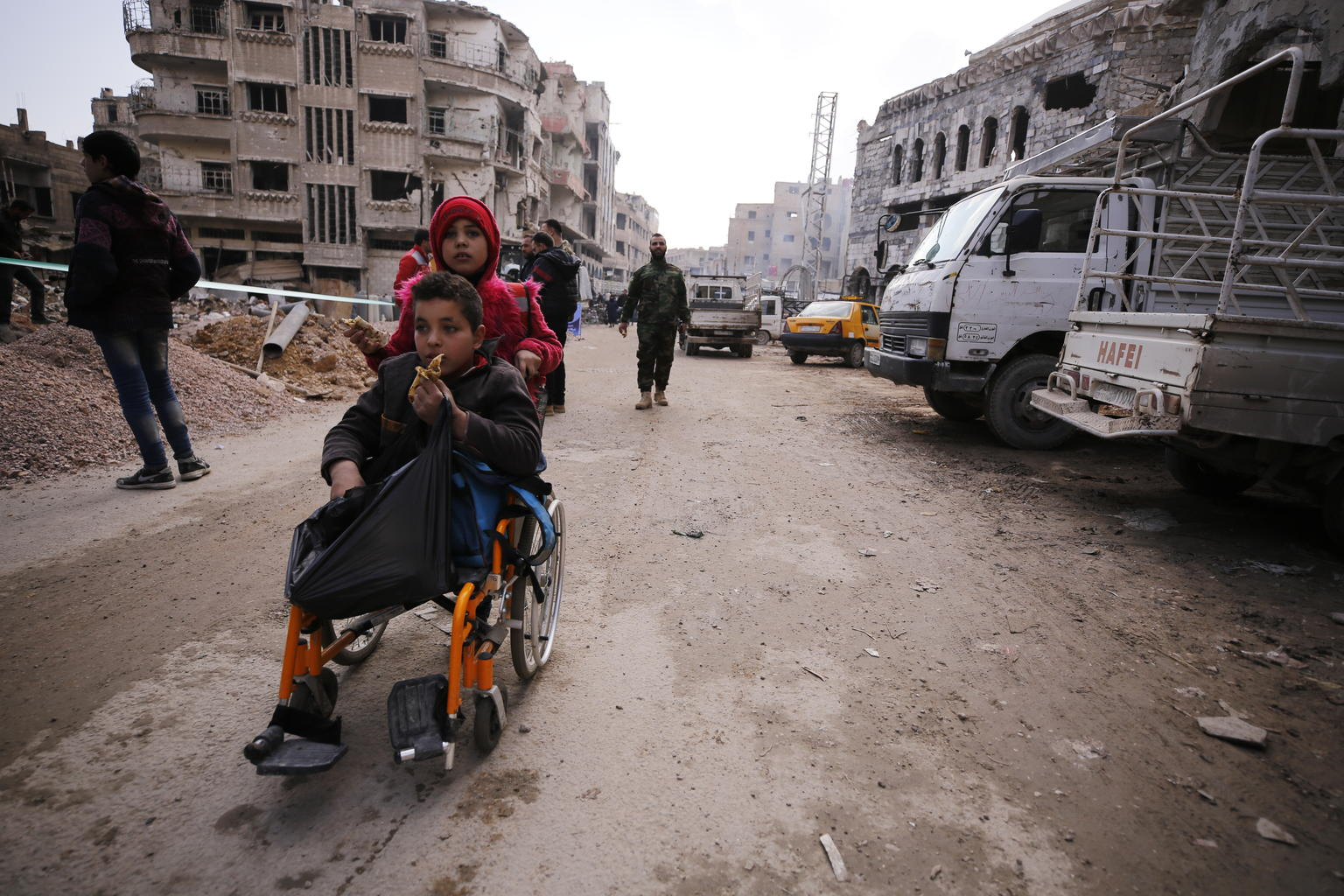UNICEF appeals for $3.9 billion in emergency assistance for 41 million children affected by conflict or disaster Millions of children without access to critical child protection services
2019-01-29
© UNICEF/UN0264239/Sanadiki
29 January 2019── Millions of children living in countries affected by conflict and disaster lack access to vital child protection services, putting their safety, well-being and futures at risk, UNICEF warned today as it appealed for $3.9 billion to support its work for children in humanitarian crises.
UNICEF’s Humanitarian Action for Children sets out the agency’s 2019 appeal and its efforts to provide 41 million children with access to safe water, nutrition, education, health and protection in 59 countries across the globe. Funding for child protection programmes accounts for $385 million of the overall appeal, including almost $121 million for protection services for children affected by the Syria crisis.
“Today millions of children living through conflict or disaster are suffering horrific levels of violence, distress and trauma,” said UNICEF Executive Director Henrietta Fore. “The impact of our child protection work cannot be overstated. When children do not have safe places to play, when they cannot be reunited with their families, when they do not receive psychosocial support, they will not heal from the unseen scars of war.”
UNICEF estimates that more than 34 million children living through conflict and disaster lack access to child protection services, including 6.6 million children in Yemen, 5.5 million children in Syria and 4 million children in the Democratic Republic of the Congo (DRC).
Child protection services include all efforts to prevent and respond to abuse, neglect, exploitation, trauma and violence. UNICEF also works to ensure that the protection of children is central to all other areas of the organisation’s humanitarian programmes, including water, sanitation and hygiene, education and other areas of work by identifying, mitigating and responding to potential dangers to children’s safety and wellbeing.
However, funding constraints, as well as other challenges including warring parties’ growing disregard for international humanitarian law and the denial of humanitarian access, mean that aid agencies’ capacity to protect children is severely limited. In the DRC, for example, UNICEF received just a third of the $21 million required for child protection programmes in 2018, while around one-fifth of child protection funding for Syrian children remained unmet.
“Providing these children with the support they need is critical, but without significant and sustained international action, many will continue to fall through the cracks,” said Manuel Fontaine, UNICEF Director of Emergency Programmes. “The international community should commit to supporting the protection of children in emergencies.”
2019 marks the 30th anniversary of the landmark Convention on the Rights of the Child and the 70th anniversary of the Geneva Conventions, yet today, more countries are emoiled in internal or international conflict than at any other time in the past three decades, threatening the safety and wellbeing of millions of children.
UNICEF’s appeal comes one month after the children’s agency said that the world is failing to protect children living in conflict around the world, with catastrophic consequences. Children who are continuously exposed to violence or conflict, especially at a young age, are at risk of living in a state of toxic stress – a condition that, without the right support can lead to negative life-long consequences for their cognitive, social and emotional development. Some children impacted by war, displacement and other traumatic events – such as sexual and gender-based violence – require specialized care to help them cope and recover.
The five largest individual appeals are for Syrian refugees and host communities in Egypt, Jordan, Lebanon, Iraq and Turkey (US$ 904 million); Yemen (US$ 542.3 million); The Democratic Republic of the Congo (US$ 326.1 million); Syria (US$ 319.8 million) and South Sudan (US$ 179.2 million).
Table 1︰Number of beneficiaries assisted/targeted of UNICEF’s humanitarian action
| Key results | Results achieved in the first 10 months of 2018 | Planned results in 2019 |
| Offers psychosocial support | 3.1 million children and caregivers | 4 million children and caregivers |
| Gives access to safe water | 35.3 million people | 42.8 million people |
| Provides basic education | 5.9 million children | 10.1 million children |
| Administers measles vaccines | 4.7 million children | 10.3 million children |
| Treats severe acute malnutrition | 2.6 million children | 4.2 million children |
Remarks︰In 2018, UNICEF had appealed for a global donation of USD$3.8 billion in support of its work. Yet, only USD$1.85 billion had been successfully raised at the end.
Table 2︰Top 10 Donors of UNICEF in 2018 (Country & Organization basis)
| Rank | Country/Organization | Amount Donated (USD$ million) |
| 1st | United States | 483.6 |
| 2nd | United Kingdom | 189.8 |
| 3rd | UN Office of the Coordination of Humanitarian Affairs | 151.5 |
| 4th | UN Central Emergency Response Fund | 125.6 |
| 5th | European Commission | 120.5 |
| 6th | Germany | 90.8 |
| 7th | Kuwait | 61.6 |
| 8th | Japan | 59.3 |
| 9th | Canada | 57.5 |
| 10th | Netherlands | 42.9 |
The Humanitarian Action for Children 2019 can be found here.
To know more about children in crises and donation, please click here.
— END —
For more information, please contact:
Hong Kong Committee for UNICEF










